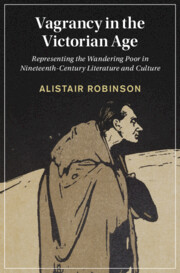 Vagrancy in the Victorian Age
Vagrancy in the Victorian Age from Part I - The Country
Published online by Cambridge University Press: 02 November 2021
The Gypsy is one of the most prominent vagrant figures in nineteenth-century literature and culture, and has received a considerable amount of critical attention. This chapter situates the Gypsy alongside other rural itinerants, such as hawkers and handicraft tramps, in order to address how racial and aesthetic assumptions conditioned the representation of Gypsies in British print culture. Focusing on the period 1830–60, this chapter first examines how a legacy of picturesque representation combined with more recent theories of extinction, and how these were combined in periodical articles that depicted the Gypsies as a ‘vanishing race’. This is followed by an in-depth analysis of George Borrow’s autobiography Lavengro (1851) and its sequel The Romany Rye (1857). Here I argue that while Borrow reiterated racial interpretations of English Gypsies, he actively critiqued the picturesque tradition that sought to idealise them and other rural itinerants in Britain. Alongside Borrow, this chapter examines works by George Eliot and Mary Russell Mitford.
To save this book to your Kindle, first ensure [email protected] is added to your Approved Personal Document E-mail List under your Personal Document Settings on the Manage Your Content and Devices page of your Amazon account. Then enter the ‘name’ part of your Kindle email address below. Find out more about saving to your Kindle.
Note you can select to save to either the @free.kindle.com or @kindle.com variations. ‘@free.kindle.com’ emails are free but can only be saved to your device when it is connected to wi-fi. ‘@kindle.com’ emails can be delivered even when you are not connected to wi-fi, but note that service fees apply.
Find out more about the Kindle Personal Document Service.
To save content items to your account, please confirm that you agree to abide by our usage policies. If this is the first time you use this feature, you will be asked to authorise Cambridge Core to connect with your account. Find out more about saving content to Dropbox.
To save content items to your account, please confirm that you agree to abide by our usage policies. If this is the first time you use this feature, you will be asked to authorise Cambridge Core to connect with your account. Find out more about saving content to Google Drive.